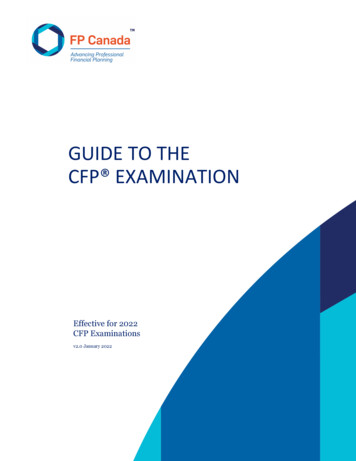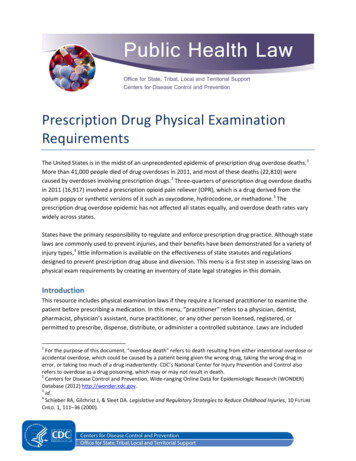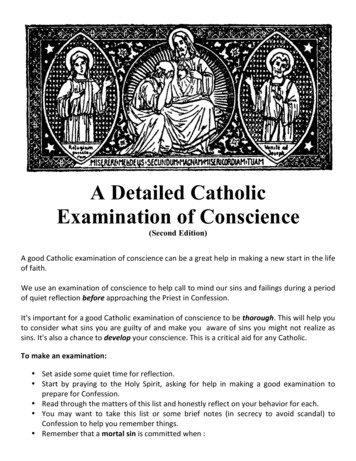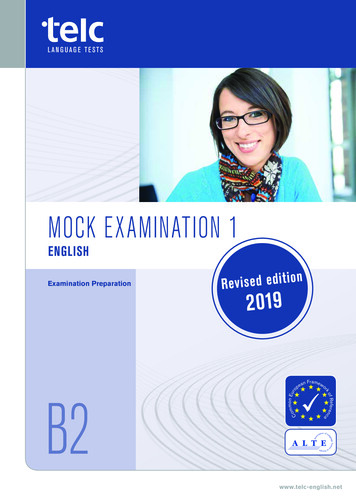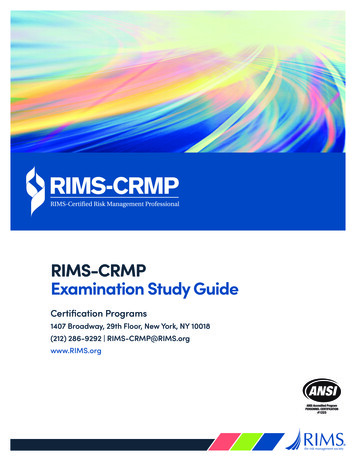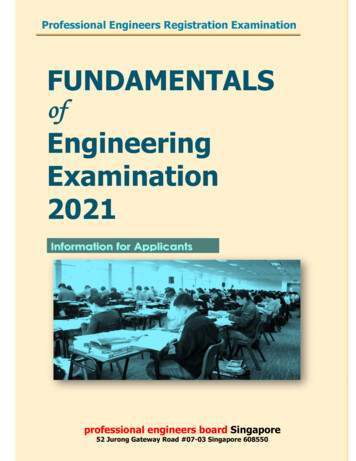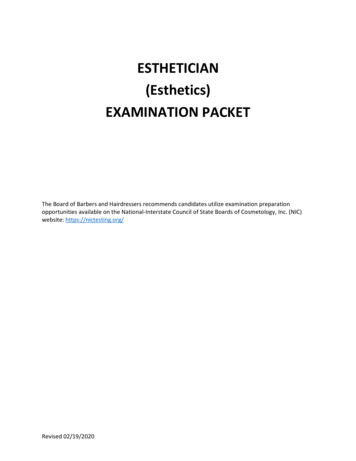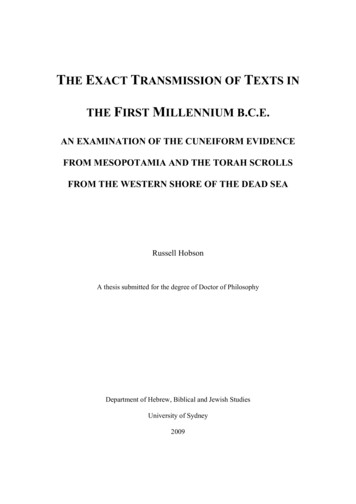
Transcription
THE EXACT TRANSMISSION OF TEXTS INTHE FIRST MILLENNIUM B.C.E.AN EXAMINATION OF THE CUNEIFORM EVIDENCEFROM MESOPOTAMIA AND THE TORAH SCROLLSFROM THE WESTERN SHORE OF THE DEAD SEARussell HobsonA thesis submitted for the degree of Doctor of PhilosophyDepartment of Hebrew, Biblical and Jewish StudiesUniversity of Sydney2009
ABSTRACTCertain ancient Near Eastern texts develop over time towards a reasonably stable state oftransmission. However, the development towards a single ‘stabilised’ transmitted formthat marks the biblical manuscripts between the second century B.C.E. and second century C.E. is often considered to permit the Hebrew bible a unique position in the ancientNear Eastern textual corpus. The degree to which the wider body of ancient Near Easterntexts actually support or undermine this position is the topic of this dissertation. Thestudy begins by formulating a methodology for comparing the accuracy with which ancient texts of varying genres and languages were transmitted. Exemplars from the firstmillennium B.C.E. cuneiform evidence are selected for analysis on the basis of genre.Texts that are preserved in more than one ancient copy are compared to determine howmuch variation occurs between manuscripts of the same text. The study begins with representative texts from the Neo-Assyrian, Neo-Babylonian and Late Babylonian periodsthat range in date from the late eighth century B.C.E. to the third century B.C.E. Thestudy then turns to the Torah scrolls from the Dead Sea area that range in date from thethird century B.C.E. to the second century C.E. The accuracy with which the cuneiformtexts were transmitted is then compared with the biblical evidence. The study finds thatthe most stable texts surveyed are those containing ritual instructions. The mechanismsthat may have led to the exact transmission of the Torah in the late Second Temple periodare discussed in the conclusion.
CONTENTSList of Tables . viiList of Figures . viiList of Abbreviations . viiiAcknowledgements . xCHAPTER 1 – INTRODUCTION . 1The Hebrew Scriptures and other ancient Near Eastern Traditions . 1Textual Criticism, Its Objectives and Presuppositions . 3Tools Available for Building a Methodology . 9Conceptual Frameworks for Viewing the Texts . 10The Categorisation of Variant Readings . 17Errors. 17Variants in Reconstructive Approaches . 19Variants in Comparative Approaches to Biblical Texts . 22Variants in Comparative Approaches to Non-Biblical Texts . 24CHAPTER 2: METHOD . 30Creating a Methodology . 30Textual Variants – Orthographic . 33Textual Variants – Orthographic (linguistic) . 34Stylistic Variants . 37i
Hermeneutic Variants . 39The Quantification of Texts . 39CHAPTER 3: INTRODUCTION TO THE CUNEIFORM TEXTS . 47Defining Parallel Texts . 47The Historical Setting . 48The History of the Collections . 52Selecting the Texts for Analysis . 53CHAPTER 4 – ENŪMA ANU ENLIL TABLET 63 . 60The Text . 60The Tablets. 61Description of the Sources . 62List of Variants Between the Parallel Sources for EAE 63 . 71Discussion of the Variants . 88Orthographic Variants. 88Orthographic (linguistic) Variants . 90Stylistic Variants (Type 2) . 90Hermeneutic Variants . 91CHAPTER 5 – MUL.APIN . 94The Text . 94The Tablets. 95ii
Description of the Sources . 96List of Variants Between the Parallel Sources for MUL.APIN . 112Discussion of Variants . 153Orthographic Variants. 153Orthographic (linguistic) Variants . 154Stylistic Variants (Type 1) . 155Stylistic Variants (Type 2) . 156Stylistic Variants (Type 3) . 157Hermeneutic Variants . 157CHAPTER 6 – THE LAWS OF HAMMURABI . 159The Text . 159The Tablets. 160Description of the Sources . 161List of Variants Between the Parallel Sources for the Laws of Hammurabi . 168Discussion of Variants . 204Orthographic Variants. 204Orthographic (linguistic) Variants . 205Stylistic Variants (Type 1) . 206Stylistic Variants (Type 2) . 207Hermeneutic Variants . 208iii
CHAPTER 7 – GILGAMESH XI . 210The Text . 210The Tablets. 211Description of the Sources . 212List of Variants Between the Parallel Sources for Gilgamesh XI . 218Discussion of Variants . 262Orthographic Variants. 262Orthographic (linguistic) Variants . 263Stylistic Variants (Type 1) . 265Stylistic Variants (Type 2) . 266Stylistic Variants (Type 3) . 267Hermeneutic Variants . 268CHAPTER 8 – MĪS PÎ. 270The Text . 270The Tablets. 271Description of the Sources . 272List of Variants Between the Parallel Sources for Mīs Pî . 281Discussion of Variants . 285Orthographic Variants. 285Orthographic (linguistic) Variants . 285iv
Stylistic Variants (Type 1) . 286Stylistic Variants (Type 2) . 287CHAPTER 9 – THE TORAH SCROLLS FROM THE DEAD SEA AREA . 288Approaching the Evidence of the Dead Sea Scrolls . 288The Sites. 302The Archaeology of Khirbet Qumran . 303The Connection Between Khirbet Qumran and the Scrolls Found Nearby . 305The Archaeology of the Masada Scrolls . 310The Sources. 313List of Variants From the MT Torah Scrolls From Qumran and Masada . 321Discussion of Variants . 456Orthographic Variants. 456Orthographic (linguistic) Variants . 457Stylistic Variants (Type 1) . 458Stylistic Variants (Type 2) . 459Stylistic Variants (Type 3) . 461Hermeneutic Variants . 461CHAPTER 10 – CONCLUSION . 463Issues in the Statistical Analysis . 463Concluding Remarks on the Cuneiform Sources . 465v
EAE63 . 465MUL.APIN . 467The Laws of Hammurabi . 468Gilgamesh XI . 471Mīs Pî . 472Concluding Remarks on The Dead Sea Torah Scrolls. 473The Significance of Ritual Texts . 477Bibliography . 496vi
List of TablesTable 1 - EAE 63: Tablets Under Examination . 62Table 2 - Number of SU preserved in the Sources for EAE 63 . 68Table 3 - Variants in the Parallel Sources for EAE 63 . 70Table 4 - MUL.APIN: Tablets Under Examination. 95Table 5 - Number of SU Preserved in the MUL.APIN Tablets . 109Table 6 - Variants in the Parallel Sources for MUL.APIN . 111Table 7 - Laws of Hammurabi: Tablets Under Examination . 161Table 8 - Number of SU Preserved in the First Millennium Hammurabi Tablets . 165Table 9 - Variants in the Parallel Sources for the Laws of Hammurabi . 167Table 10 - First Millennium Sources for Gilgamesh XI Under Examination. 211Table 11 - Number of SU Preserved in the First Millennium Gilgamesh XI Tablets . 215Table 12 - Variants in the Parallel Sources for Gilgamesh XI . 217Table 13 - Sources for mīs pî Under Examination . 271Table 14 - Number of SU Preserved in the Sources for Mīs Pî . 278Table 15 - Variants in the Parallel Sources for Mīs Pî . 280Table 16 - Number of SU Preserved in the Torah Scrolls From the Dead Sea Area. 314Table 17 - Variants From the MT in the Dead Sea Torah Scrolls . 317List of FiguresFigure 1 - Average Variation Of All Sources . 465Figure 2 - Average Variation Including Nineveh Ritual Tablets and 'de Luxe' mss . 477vii
List of AbbreviationsAChC. Virolleaud, L’Astrologie ChaldéeneAfOArchiv für Orientforschung (24 H. Hunger, MUL.APIN)AHwW. Von Soden, Akkadisches HandwörterbuchAOtablets in the collections of the Musée du LouvreBGPJ. Black, A.R. George and N. Postgate, A Concise Dictionary of AkkadianBINBabylonian Inscriptions in the Collection of J.B. Nies (4 A.T. Clay,Letters and Transactions from Cappadocia)BMtablets in the collections of the British MuseumBPOBabylonian Planetary Omens (1 E. Reiner and D. Pingree, The Venus Tablet of Ammisaduga)CADThe Assyrian Dictionary of the Oriental Institute of the University ofChicagoCTCuneiform Texts from Babylonian Tablets in the British MuseumCTNCuneiform Texts from NimrudDTtablets from G. Smith’s 1873 expedition, now in the BMHALOTL. Koehler and W. Baumgartner, Hebrew and Aramaic Lexicon of theOld TestamentHVhermeneutic variantKtablets in the Kuyunjik collection of the British Museumviii
KAOA. Jeremias, H. Winckler and E.F. Weidner, Kampfe um dem altenOrientKBoKeilschrifttexte aus BoghazköiKTS 1J. Lewy, Die altassyrischen Texte vom Kültepe bei KaisarijeLXXSeptuagintMTMassoretic TextOVorthographic variantOV(l)orthographic variant (linguistic)PBSPublications of the Babylonian Section, University Museum, University of PennsylvaniaRLAReallexicon der AssyriologieRawlCuH. Rawlinson, Cuneiform Inscriptions of Western AsiaRmtablets in the collection of the British Museum from H. RassamSmtablets in the collection of the British Museum from G. SmithSptablets in the collections of the British Museum acquired from SpartaliSPSamaritan PentateuchSTTD.R. Gurney, J.J. Finkelstein and P. Hilun, The Sultantepe tabletsSUsemogenic unitSVstylistic variantVATtablets in the collections of the Staatliche Museen, Berlinix
AcknowledgementsDuring the course of my research I have come into contact with several scholars, bothestablished and emerging, without whose advice and insights this dissertation would havebeen much diminished. The foremost of these is Dr Ian Young, my supervisor and mentor, to whom I owe the initial inspiration for this thesis. His tireless efforts in reading themany drafts of this document, as well as his constant advice and friendship throughoutthe entire research process have proved invaluable.I owe thanks to Ms Lucy Davey, Dr Robyn Vern and Dr Noel Weeks at the University ofSydney for their advice and support. I also owe thanks to Luis Siddall at the School ofOriental and African Studies at the University of London for bringing to my attentionseveral pertinent articles in the scholarly literature of which I would otherwise have remained ignorant.The Trustees of the Sir Zelman Cowen Universities Fund afforded me the opportunity toresearch at the Hebrew University of Jerusalem during the Spring semester of 2007.Studying at the Hebrew University significantly broadened the scope of my researchthanks to the advice of several people. In particular I would like to thank Professor Mordechai Cogan for supervising my research at the Hebrew University and for giving sofreely of his time, and also Professor Wayne Horowitz who directed me towards some ofthe more significant cuneiform astronomical literature included in this study.x
I am indebted to the Orion Center for the Study of the Dead Sea Scrolls, and the Center’sdirector Professor Steven E. Fassberg, for providing valuable resources and support during my time in Jerusalem. Professor Avi Hurvitz contributed much guidance in the development of the methodology for this study, in particular the system for the classification ofvariants. Professor Emanuel Tov was also very generous with his time and provided somehelpful suggestions and observations.Finally and most importantly I owe the greatest debt of gratitude to my partner, BrionyDunn, who has been unceasing in her support during the last eight and a half years that Ihave spent in full time study. Without her I would never have had the capacity to complete this dissertation. It is also a truth that her support in this regard is only a small partof what she gives to me each day. During the last 15 months of my research she has firstcarried and then cared for our first child while I have, for the most part, had my head buried selfishly in books and papers. I look forward to rejoining her and our son now thatthis task has finally reached its end.xi
CHAPTER 1 – INTRODUCTIONThe Hebrew Scriptures and other ancient Near Eastern TraditionsIt has been said that the textual history of the Hebrew Bible represents a unique development in the ancient Near Eastern textual corpus.1 No other ancient Near Eastern text appears to have undergone quite the same recensional activity.2 Whether we view the background of biblical texts as conforming to the regional delineation of textual traditions,3 oras stemming from more diverse localised sources,4 we must still reckon with the problemthat the biblical text seems to have undergone a degree of recensional activity that has notyet been recognised in other ancient Near Eastern textual traditions.51S. Talmon, "The Old Testament Text," The Cambridge History of the Bible: From the Beginnings toJerome (eds P.R. Ackroyd and C.F. Evans; Cambridge: Cambridge University Press, 1970) 161.2See the comments in J.H. Tigay, "Introduction," Empirical Models for Biblical Criticism (ed. J.H. Tigay;Philadelphia: University of Pennsylvania Press, 1985) 2-3.3See F.M. Cross, "The History of the Biblical Text in the Light of Discoveries in the Judaean Desert,"Harvard Theological Review 57 (1964), and "The Evolution of a Theory of Local Texts," Qumran and theHistory of the Biblical Text (Massachusetts: Harvard University Press, 1975). More recently see F.M.Cross, The Ancient Library of Qumran (Minneapolis: Fortress Press, 19953) 188-94 and From Epic toCanon (Maryland: The John Hopkins University Press, 1998) 211 n. 12, and the references there. For acritical review of the theory that calls into question some of its primary data, see G. Howard, "Frank Crossand Recensional Criticism," VT 21, 4 (1971), 440-450.4See S. Talmon, "Aspects of the Textual Transmission of the Bible in the Light of Qumran Manuscripts,"Textus 4 (1964) 97-98, and "The Old Testament Text," The Cambridge History of the Bible: From the Beginnings to Jerome (eds P.R. Ackroyd and C.F. Evans; Cambridge University Press, 1970; repr., Cambridge: Cambridge University Press, 1994) 162.5See J.H. Tigay, "The Evolution of the Pentateuchal Narratives in the Light of the Evolution of the Gil-gamesh Epic," Empirical Models for Biblical Criticism (ed. J.H. Tigay; Philadelphia: University of Pennsylvania Press, 1985), where a comparative analysis with the evolution of the Gilgamesh Epic shows thatany conjectural process that scholars might develop to recreate the early forms of the Epic based on later1
How might we understand the development of the Hebrew scriptures in respect of othertextual traditions in the ancient Near East? Is the reduction of several biblical textual traditions towards the ‘standard text’ that emerged by the second century C.E. a unique phenomenon in ancient Near Eastern textual history? Do any other ancient Near Eastern textsshow tendencies toward a level of standardisation that is comparable with the almost letter-perfect editions of the Hebrew scriptures in all of our evidence from at least the second century C.E. onward? By what method can we make legitimate comparisons betweenthe way the biblical text developed and the way other ancient Near Eastern texts developed?Answers to such questions require the establishment of a method for analysing variousancient texts, in multiple copies, over a wide geographical and temporal distribution. Anymethod for analysing texts from various localities, periods, genres, and languages wouldneed to be flexible and broad in its categorisation of variant readings, and unbiased in theway it delimited quanta within the different texts. Variant categories would need to beweighed for significance so that some idea could be obtained about what type of variations were common in a given tradition, and what kind were not.In fact, several models exist for comparative analyses of ancient texts. A selection ofthose that pertain to texts written in Semitic languages will be considered here. Althoughthe majority of these operate in a single linguistic setting, some synthesis of these sysrecensions is more than likely to be largely incorrect. Such an analysis cautions scholars who reconstructearlier unattested forms of the biblical text based on source- and text-critical arguments.2
tems will be attempted to frame an analysis that works across different languages, scriptsand media.Textual Criticism, Its Objectives and PresuppositionsA characteristic of textual criticism of the Hebrew Bible has been the concern of scholarsto reconstruct the ‘original’ form of each individual text. This is “the text or edition (or anumber of consecutive editions) that contained the finished literary product and whichstood at the beginning of the process of textual transmission.”6 Indeed, according to Tovit is this “final authoritative copy which it is the object of textual criticism to reconstruct,even if only in isolated details.”7 The text critic of the Hebrew Bible, then, aims to reconstruct one text that he or she believes to be historical.8This approach must proceed from two obvious assumptions. The first is that a single textdid in fact stand at the beginning of the transmission process, before it was corrupted bymechanical and recensional processes.9 This must necessarily be true, otherwise the objective of this approach to textual criticism must be redefined. The second assumption isthat the end result of the process was the standardised form of the Hebrew scriptures that6E. Tov, Textual Criticism of the Hebrew Bible (Minneapolis: Fortress Press, 20012) 171.7E. Tov, Textual Criticism, 177.8According to P.K. McCarter, Textual Criticism: Recovering the Text of the Hebrew Bible (Philadelphia:Fortress Press, 1986) 12, “The goal [of text criticism] is the determination of a primitive text to which thevarious surviving copies bear witness.”9See E. Tov, Textual Criticism, where this ‘original text’ is more specifically defined as “. a text whichwas considered authoritative (and hence also finished at the literary level), even if only by a limited groupof people, and which at the same time stood at the beginning of a process of copying and textual transmission.”3
in effect became the ‘copy-text’ of the Hebrew Bible as it is reflected in all of the medieval manuscript evidence.10 In the words of Eugene Ulrich “. the term ‘standard text’ implies or even denotes a single text which is not only fixed, but is acknowledged to be ‘thetext,’ as opposed to other forms of the text.”11Some care is needed here, for it is not the view of the writer that either of these assumptions is necessarily incorrect, but it is important to highlight the position from which thisapproach to textual criticism advances, for it significantly affects the way the evidence isanalysed.There is, it may be said, a general preference when reconstructing ancient texts to presentthem in a standardised form, even though in history many of these texts existed in different forms. One need only look at Pritchard’s “Ancient Near Eastern Texts”,Charlesworth’s “Pseudepigrapha”, or Foster’s “Before the Muses” to see that varying10That all variant readings in medieval manuscripts are genetic, and result from the corruption of a singlecopy-text is illustrated clearly in M.H. Goshen-Gottstein, "Hebrew Biblical Manuscripts: Their History andTheir Place in the HUBP Edition," Biblica 48 (1967). See also S. Talmon, "Old Testament Text," 170-175.The term ‘copy-text’ usually refers to an authoritative manuscript that is to be set in type, however its usein this context seems justified, assuming, with the majority of scholars, that the faithful reproduction of thisspecific text was the intention of copyists by the first century C.E. See primarily R.B. McKerrow, Prolegomena for the Oxford Shakespeare: A Study in Editorial Method (Oxford: Clarendon Press, 1939) 8, forthe use of the term in reference to the textual criticism of the plays of Shakespeare. Its use was properlyexplored and defined in a lecture prepared for the British Institute by W.W. Greg that was actually delivered by J. M. Osbourne, in 1949 and published in 1950 (see W.W. Greg, "The Rationale of Copy-Text,"Studies in Bibliography 3 [1950] 19-36). Most recently see the discussion in R. Hendel, "The Oxford Hebrew Bible: Prologue to a New Critical Edition," VT 58, 3 (2008) 343-46.11E. Ulrich, "The Qumran Biblical Scrolls - The Scriptures of Late Second Temple Judaism," The DeadSea Scrolls in Their Historical Context (eds T.H. Lim, L.W. Hurtado, A.G. Auld, and A. Jack; Edinburgh:T&T Clark, 2000) 69 (italics in original).4
copies of ancient texts are frequently presented in translation as single composite versions. The case is similar with the bulk of critical editions, as a cursory glance at the textof BHS will confirm. The copy-text, in this case the Leningrad Codex, is accompanied bya critical apparatus that is purposefully positioned to leave the text, to as great an extentas possible, free from distracting notation and comment. The elected text of the critic isthe unmistakeable focus, with other evidence from less authoritative manuscripts relegated to the apparatus.12That is not to say that our translations and critical editions lack any significant information. The focus on a no
THE EXACT TRANSMISSION OF TEXTS IN THE FIRST MILLENNIUM B.C.E. AN EXAMINATION OF THE CUNEIFORM EVIDENCE FROM MESOPOTAMIA AND THE TORAH SCROLLS FROM THE WESTERN SHORE OF THE DEAD SEA Russell Hobson A thesis submitted for the degree of Doctor of Philosophy



